This is part of a series of posts analyzing the findings of the recent Nature papers Olalde et al.(2018) and Mathieson et al.(2018) (abbreviated O&M 2018).
The recent publication of Narasimhan et al. (2018) has outdated the draft of this post a bit, and it has made it at the same time still more interesting.
While we wait for the publication of the dataset (and the actual Y-DNA haplogroups and precise subclades with the revision of the paper), and as we watch the wrath of Hindu nationalists vented against the West (as if the steppe was in Western Europe) and science itself, we have already seen confirmation from the Reich Lab of their new approach to Late Proto-Indo-European migrations.
Yamna/Steppe EMBA, previously identified as the direct source of “steppe” ancestry (AKA ‘Yamnaya‘ ancestry) and Late Indo-European migrations in Asia – through Corded Ware, it is to be understood – has been officially changed. In the case of Indo-Iranian migrations it is the “Steppe MLBA cloud”, after a direct contribution to it of Yamna/Steppe EMBA, which expanded Indo-Iranian, as I predicted ancient DNA could support.
In Twitter, the main author responded the following when asked for this change regarding the origin of steppe ancestry in Asian migrants (emphasis mine):
Our reasons are:
- The Turan samples show no elevated steppe ancestry till 2000BC.
- MLBA is R1a
- Indus periphery doesn’t have steppe ancestry but Swat does, and EMBA doesn’t work both in terms of time or genetic ancestry to explain the difference.
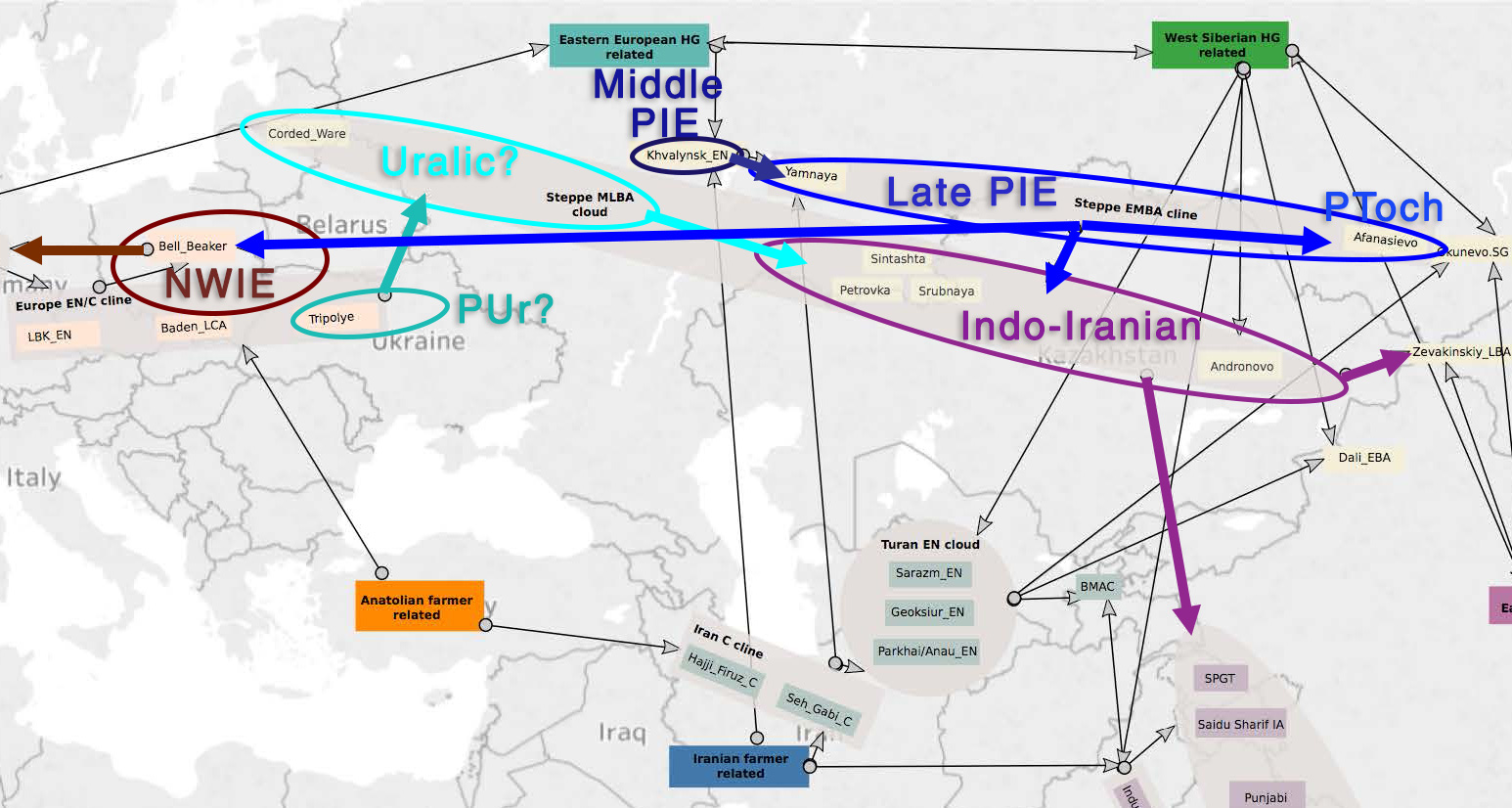
I am glad to see finally recognized that Y-DNA haplogroups and time have to be taken into account, and happy also to see an end to the by now obsolete ‘ADMIXTURE/PCA-only relevance’ in Human Ancestry. The timing of archaeological migrations, the cultural attribution of each sample, and the role of Y-DNA variability reduction and expansion have been finally recognized as equally important to assess potential migrations, as I requested.
This change was already in the making some months ago, when David Anthony – who has worked with the group for this paper and others before it – already changed his official view on Corded Ware – from his previous support of the 2015 model. His latest theory, which linked Yamna settlements in Hungary with a potential mixed society of migrants (of R1b-L23 and R1a-Z645 lineages) from West Yamna, is most likely wrong, too, but it was clearly a brave step forward in the right direction.
The only reasonable model now is that Yamna expanded Late Proto-Indo-European languages with steppe ancestry + R1b-L23 subclades.
You can either accept this change, or you can deny it and wait until one sample of R1a-Z645 appears in West Yamna or central Europe, or one sample of R1b-L23 appears in Corded Ware (as it is obvious it could happen), to keep spreading the wrong ideas still some more years, while the rest of the world goes on: Mallory, Anthony, and other archaeologists co-authoring the latest paper (probably part of the stronger partnership with academics that we were going to see), who had formally put forward complex, detailed theories, investing their time and name in them, have rejected their previous migration models to develop new ones based on the most recent findings. If they can do that, I am sure any amateur geneticist out there can, too.
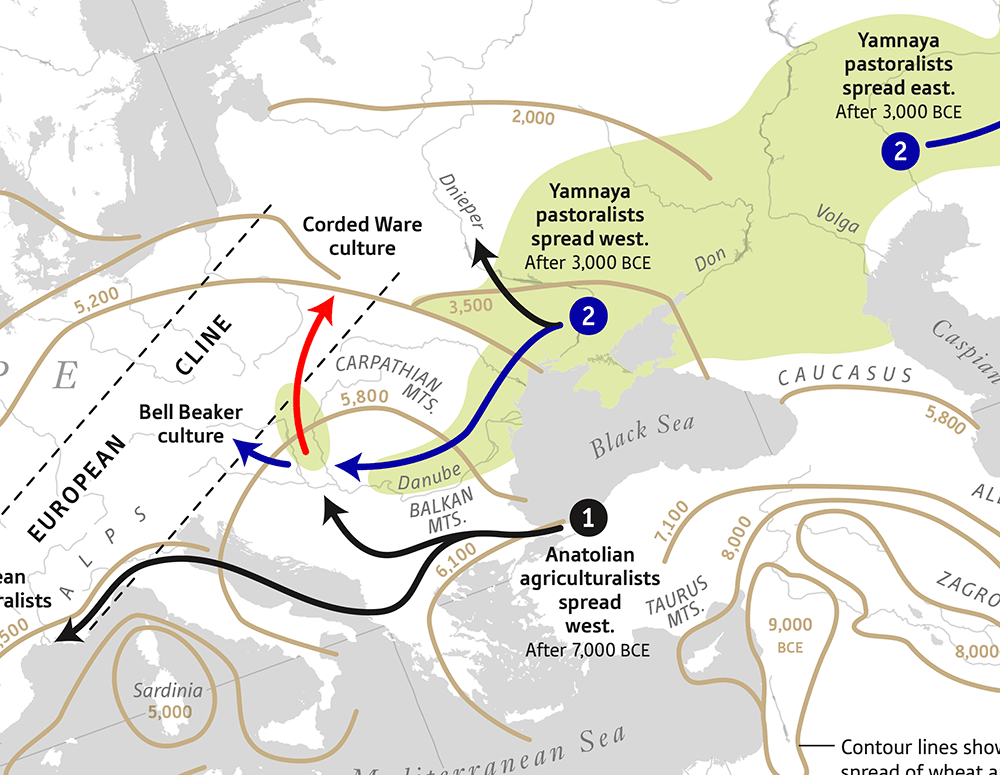
The Balto-Slavic dialect and its homeland
An interesting question in Linguistics and Archaeology, now that Corded Ware cannot be identified as “Indo-Slavonic” or any other imaginary ancient group (like Indo-Slavo-Germanic), remains thus mostly unchanged since before the famous 2015 genetic papers:
- Was Balto-Slavic a dialect of the expanding North-West Indo-European language, a Northern LPIE dialect, as we support, based on morphological and lexical isoglosses?
- Or was it part of an Indo-Slavonic group in East Yamna, i.e. a Graeco-Aryan dialect, based mainly on the traditional Satem-Centum phonological division?
I am a strong supporter of Balto-Slavic being a member of a North-West Indo-European group. That’s probably because I educated myself first with the main Spanish books* on Proto-Indo-European reconstruction, and its authors kept repeating this consistent idea, but I have found no relevant data to reject it in the past 15 years.
* Today two of the three volumes are available in English, although they are from the early 1990s, hence a bit outdated. They also maintain certain peculiarities from Adrados’ own personal theories, such as multiple (coloured) laryngeals, 5 cases – with a common ancestral oblique case – for Middle PIE, etc. But it has lots of detailed discussions on the different aspects of the reconstruction. It is not an easy introductory manual to the field, though; for that you have already many famous short handbooks out there, like those of Fortson (N.American), Beekes (Leiden), or Meier-Brügger (Germany).
Fernando and I have always maintained that North-West Indo-European must have formed a very recent community, probably connected well into the early 2nd millennium BC for certain recent isoglosses to spread among its early dialects, based on our guesstimates*, and on our belief that it formed at some point not just a dialect continuum, but probably a common language, so we estimated that the expansion was associated with the pan-European influence of Únětice and close early Bronze Age European contacts.
NOTE. I know, you must be thinking “linguistic guesstimates? Bollocks, that’s not Science”. Right? Wrong. When you learn a dozen languages from different branches, half a dozen ancient ones, and then still study some reconstructed proto-languages from them, you begin to make your own assumptions about how the language changes you perceive could have developed according to your mental time frames. If you just learned a second language and some Latin in school, and try to make assumptions as to how language changes, or you believe you can judge it with this limited background, you have evidently the wrong idea of what a guesstimate is. I accept criticism to this concept from a scientist used only to statistical methods, since it comes from pure ignorance of what it means. And I accept alternative guesstimates from linguists whose language backgrounds may differ (and thus their perception of language change). However, I would not accept a glottochronological or otherwise (supposedly) statistical model instead (or a religious model, for that matter), so we have no alternatives to guesstimates for the moment.
In fact, guesstimates and dialectalization have paved the way to the steppe hypothesis, first with the kurgan hypothesis by Marija Gimbutas, then complemented further in the past 60 years by linguists and archaeologists into a detailed Khvalynsk -> Yamna -> Afanasevo/Bell Beaker/Sintashta-Andronovo expansion model, now confirmed with genomics. So either you trust us (or any other polyglot who deals with Indo-European matters, like Adrados, Lehmann, Beekes, Kloekhorst, Kortlandt, etc.), or you begin learning ancient languages and obtaining your own guesstimates, whichever way you prefer. The easy way of numbers + computer science does not exist yet, and is quite far from happening – until we can understand how our brains summarize and select important details involved in obtaining estimates – , no matter what you might be reading (even in Nature or Science) recently…
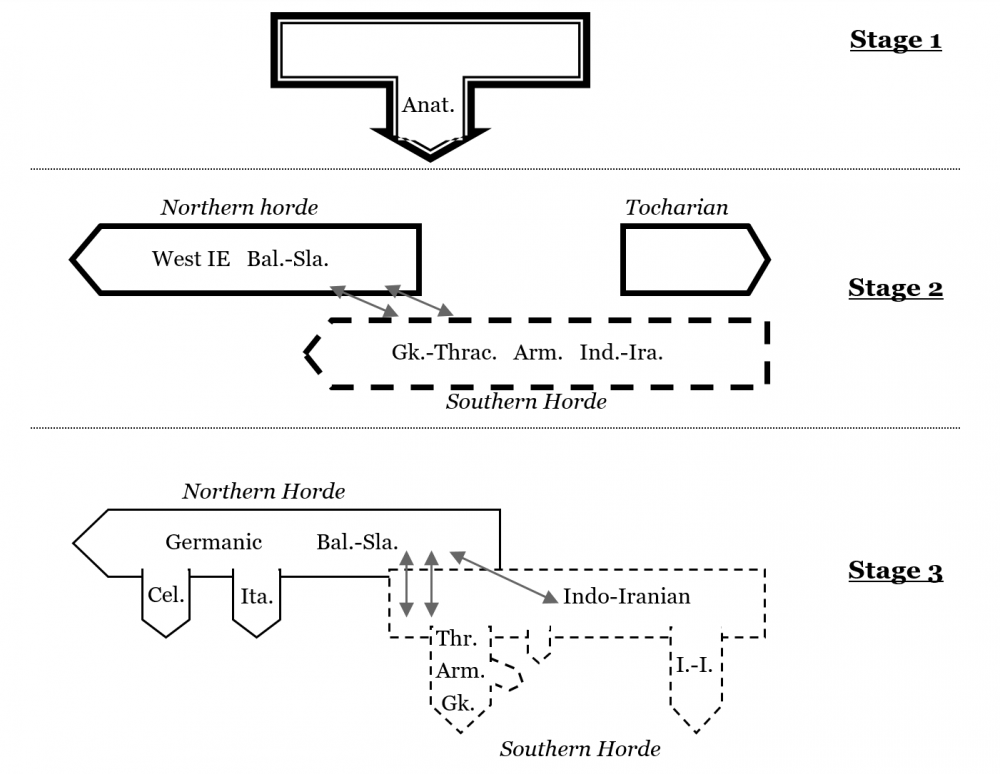
Data from the 2015 papers changed my understanding of the original NWIE-speaking community, and I have since shifted my preffered anthropological model (from a Northern dialect in Yamna spreading into a loose NWIE-speaking Corded Ware -> Únětice) to a quite close group formed by late Yamna settlers in the Carpathian Basin, expanded as East Bell Beakers, and later continuing with close contacts through Central European EBA.
NOTE. As you can read, we initially rejected Gimbutas’ and Anthony’s (2007) notion of a Late PIE splitting suddenly into all known dialects (viz. Italo-Celtic with Vučedol/Bell Beaker), and looked thus for a common NWIE spread with Corded Ware migrants, with help from inferences of modern haplogroup distribution (as was common in the early 2000s). Language reconstruction was the foundation of that model, and it was right in its own way. It probably gave the wrong idea to geneticists and archaeologists, who quite easily accepted some results from the 2015 papers as supporting this model. But it also helped us develop a new model and predict what would happen in future papers, as demonstrated in O&M 2018. Any alternative linguistic and archaeological model could explain what is seen today in genomics, but our model of North-West Indo-European reconstruction is obviously at present the best fit for it.
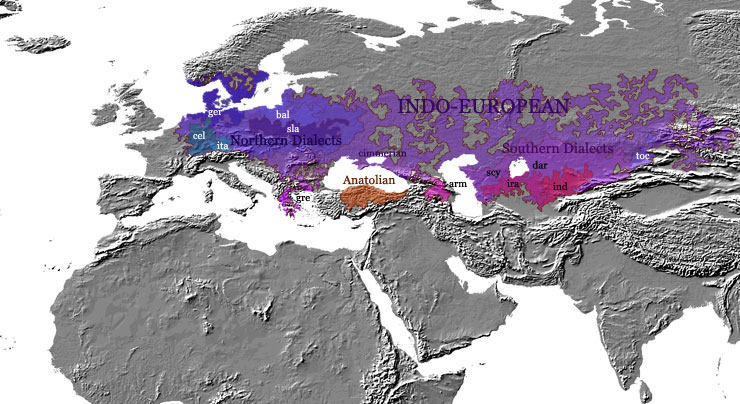
Nevertheless, one of the most important Balticists and Slavicists alive, Frederik Kortlandt, posits that there was in fact an Indo-Slavonic group, so one has to take that possibility into account. Not that his ideas are flawless, of course: he defends the glottalic theory – which is still held today by just a handful of researchers – , and I strongly oppose his description of Balto-Slavic and Germanic oblique cases in *-m- (against other LPIE *-bh-) as an ancestral remnant related to Anatolian (an ending which few scholars would agree corresponds to what he claims), since that would probably represent an older split than warranted in our model. I believe genetics is proving that the dialectalization of Late PIE happened as Fernando López-Menchero and I described.
NOTE. The idea with these examples of how he has been wrong in LPIE and MPIE reconstruction is not to observe the common ad hominem arguments used by amateur geneticists to dismiss academic proposals (“he said that and was wrong, ergo he is wrong now”). It is to bring into attention that the argument from authority is important for the academic community insofar as it creates a common ground, i.e. especially when there are many relevant scholars agreeing on the same subject. But, indeed, any model can and should be challenged, and all authorities are capable of being wrong, and in fact they often are.
The most common explanation today for the dialectal development *-m- is an innovation (not an archaism), whether morphological (viz. Ita. and Gk. them. pl *-i) or phonological (as I defend); and the most commonly repeated model for the satemization trend (even for those supporting a three-dorsal theory for PIE) is areal contact, whether driven by a previous (most likely Uralic) substratum, or not. Hence, if Kortlandt’s main different phonological and morphological assessments of the parent language are flawed, and they are the basis for his dialectal scheme, it should be revised.
The ‘atomic bomb’ that Indo-Slavonic proponents launched, in my opinion, was Holzer’s Temematic (born roughly at the same time as the renewed Old European concept in North-West Indo-European model of Oettinger) – and indeed Kortlandt’s acceptance of it. It seems to me like the linguistic equivalent of the archaeological “patron-client relationship” proposed by Anthony for a cultural diffusion of Late PIE into different Corded Ware regions: almost impossible to be fully rejected, if the Indo-Slavonic superstrate is proposed for a relatively early time.
In my opinion, the shared morphological layer with North-West Indo-European is obviously older than Iranian influence on Slavic, and I think this is communis opinio today. But how could we disentangle the dialectalization of Balto-Slavic, if there is (as it seems) an ancestral substrate layer (most likely Uralic) common to both Balto-Slavic and Indo-Iranian? It seems a very difficult task.
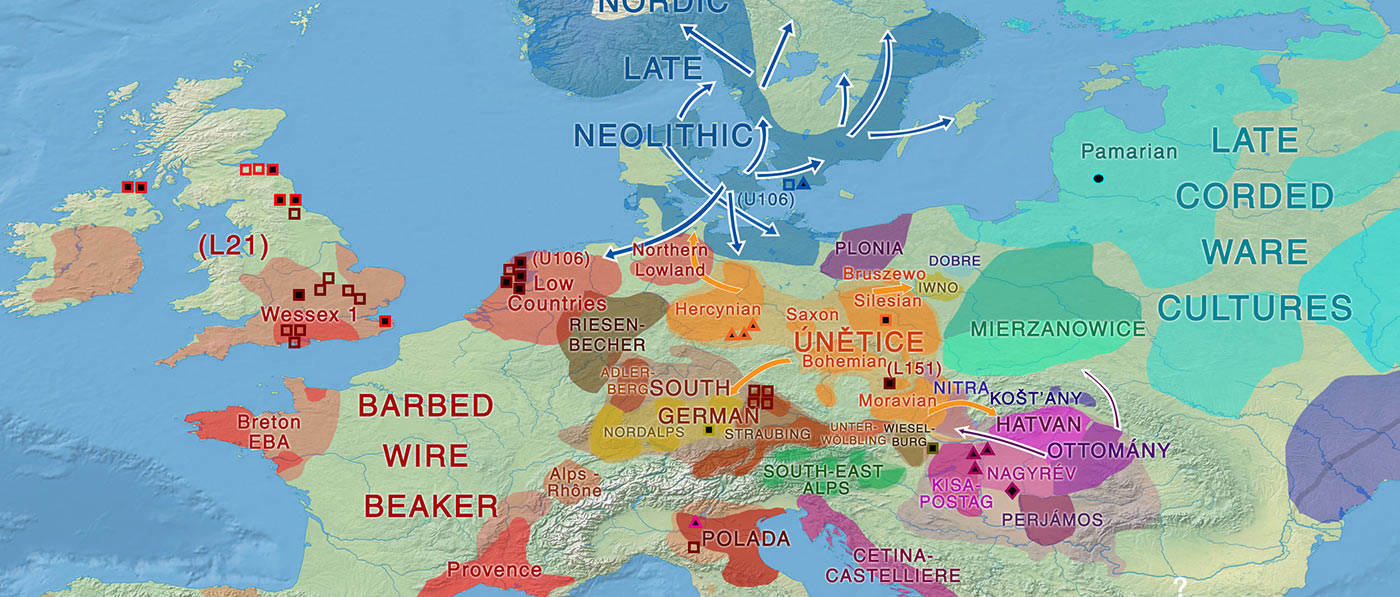
The expansion of Balto-Slavic
In any case, there are two, and only two mainstream choices right now.
NOTE. Mainstream, as in representing trends current today among Indo-Europeanists, so that many programs around the world would explain these alternative models to their students, or they would easily appear in most handbooks. Not like the word “mainstream” you read in any comment out there by anyone who has never been interested in Indo-European studies, and uses any text from any author, written who knows how long ago, merely to justify their ethnic preconceptions coupled with certain genomic finds.
You can agree with:
A) The Spanish and German schools of thought, together with many American and British scholars, as well as archaeologists like Heyd, Mallory, or Prescott, and now Anthony, too: the language ancestral to Balto-Slavic, Germanic, and Italo-Celtic accompanied expanding West Yamna/East Bell Beakers into Europe, and then their speakers – like the rest of peoples everywhere in Europe – admixed later in the different regions.
B) Frederik Kortlandt and other Indo-Slavicists. The ‘original’ Balto-Slavic would have spread with Srubna (and likely Potapovka before it), as a product of the admixture of East Yamna’s Indo-Slavonic with incoming Corded Ware migrants (this would correspond to my description of Indo-Iranian). ‘True’ Balto-Slavic speakers would have then absorbed the Temematic-speaking migrants (equivalent to early Balto-Slavic migrants as described in the demic diffusion model) spreading from the west, most likely in the steppe. Later developments from the steppe would have then brought Baltic to the north, and Slavic to the west.
Therefore, in both cases the language spoken by early R1a-Z645 lineages in Únětice or Mierzanowice/Nitra EBA cultures would have been an eastern North-West Indo-European dialect associated with expanding Bell Beakers, and closely related to Germanic and Italo-Celtic. In the second case, the ancient samples we see genetically closer to modern West Slavs could thus be identified with those speaking the Temematic substrate absorbed later by Balto-Slavic, or maybe by Balts migrating northward, and Slavs spreading west- and southward.
NOTE. In any case, we know that R1a-Z645 subclades resurged in Central-East Europe after the expansion of Bell Beakers, potentially showing an ancient link with the prevalent R1a subclades in the region today. We know that some ancient Central European populations cluster near modern West Slavs, but in other interesting regions (like the British Isles, Central Europe, Scandinavia, or Iberia) we also see close clusters, and nevertheless observe historically documented radical ethnolinguistic changes, as well as many different subsequent genetic inflows and founder effects, that have significantly altered the anthropological picture in these regions, so it could very well be that the lineages we find in ancient samples do not correspond to modern West Slavic lineages, or even similar ancient and modern lineages could show a radical cultural discontinuity (as is likely the case in this to-and-from-the-steppe migration scheme).
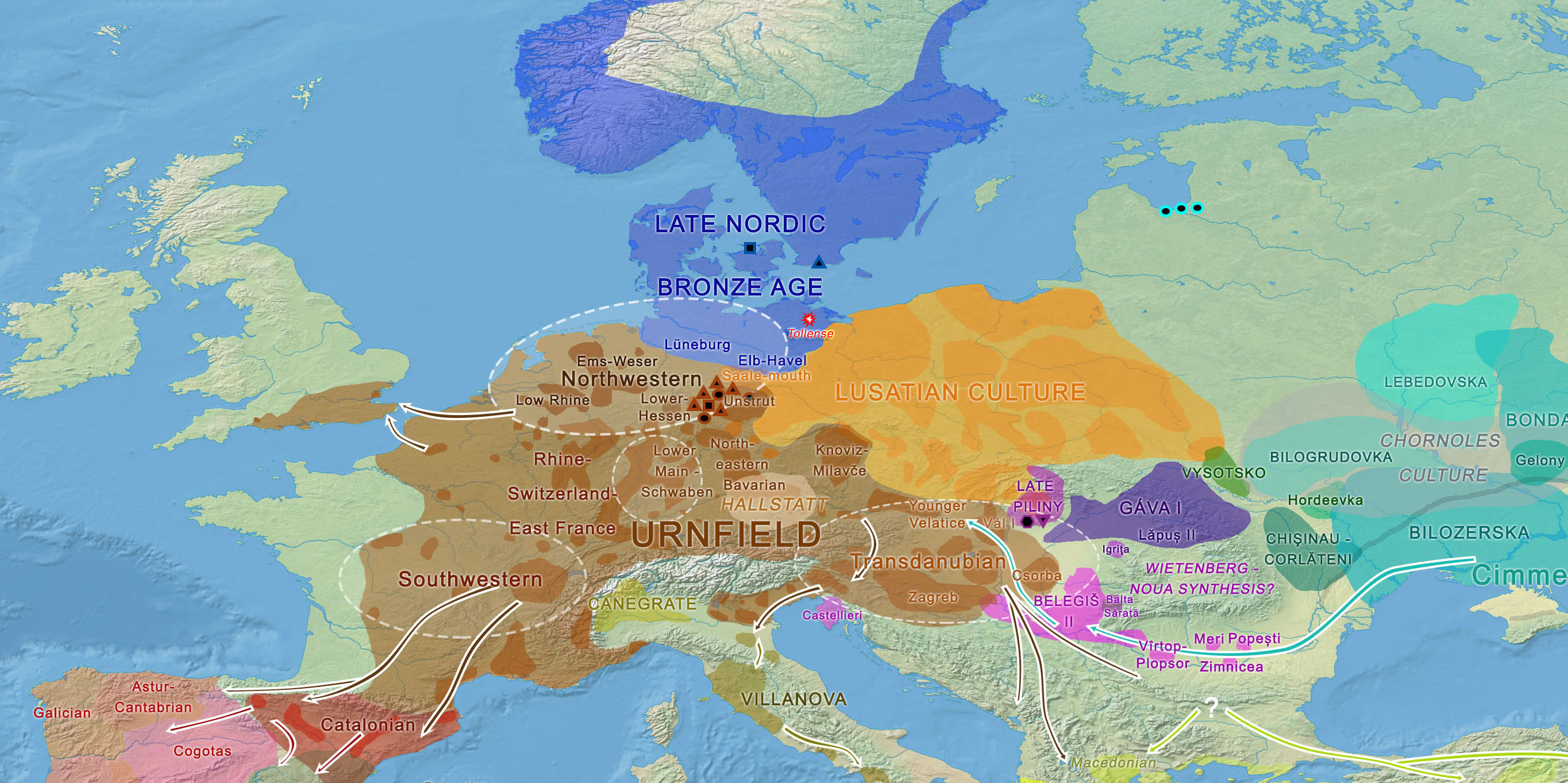
Since we are going to see signs of both – west and east admixture – in early Slavic communities near the steppe, and the distribution from South, West, and East Slavs will include a wide “cloud” connecting Central, East, and South-East Europe, as it is evident already from early Germanic samples, it may be interesting to shift our attention to the Tollense valley and Lusatian samples, and their predominant Y-DNA haplogroups. Once again, tracking male-driven migrations from Central Europe to the Baltic region and the steppe, and back again to much of Central and South Europe, will determine which groups expanded this eastern NWIE dialect initially and in later times.
Since Baltic and Slavic languages are attested quite late, genetics is likely to help us select among the different available models for Balto-Slavic, although (it is worth repeating it) these lineages may not be the same that later expanded each dialect.
NOTE. Bronze and Iron Age samples might begin to depict the true Balto-Slavic migration map. Apart from the strong differences in the satemization processes seen among Baltic, Slavic, and Indo-Iranian, from an archaeological point of view the geographic location of the earliest attested Baltic languages and the prehistoric developments of the region seem to me almost incompatible with a homeland in the steppe. Anyway, in the worst-case scenario – for those of us who work with Balto-Slavic to reconstruct North-West Indo-European – there is consensus that there must an eastern North-West Indo-European language (which some would call Temematic), whose common traits with Germanic and Italo-Celtic we use to reconstruct their parent language. The question remains thus mostly theoretical, of limited pragmatic use for the reconstruction.
The third way: Baltic Late Neolithic
I have referred to Kristiansen and his group‘s position regarding Corded Ware as Indo-European as flawed before. While their latest interpretation (and language identification) was wrong, Kristiansen’s original idea of long-lasting contacts in the Dnieper-Dniester region with the area occupied by late Trypillia developing a Proto-Corded Ware culture was probably right, as we are seeing now.
New data in Mittnik et al. 2018 show some interesting early Late Neolithic samples from the Baltic region – Zvejnieki, Gyvakarai1 (R1a-Z645) and Plinkaigalis242 – , proving what I predicted: that elevated steppe ancestry and R1a-Z645 subclades would be found in the Dnieper-Dniester region unrelated to the Yamna expansion, and, it seems, to migrants of the Corded Ware A-horizon.
Funnily enough, this shows that there were probably ancient interactions in the region, as originally asserted by Kristiansen, and probably following some of Victor Klochko‘s proposed exchange paths, but earlier than predicted by him.
Nevertheless, linguist Guus Kroonen (from Kristiansen’s workgroup) issued a quick response to O&M 2018 in yet another twist of his agricultural substrate theory, changing Corded Ware from the vector to a vector of expansion of Late Proto-Indo-European languages (thus following again strictly Gimbutas’ oudated model), which fails thus to tackle the main inconsistencies of their previous models, as shown now with the latest paper on South Asian migrations. As I said, they were always one step behind Anthony, and they still are.
Funny also how Anthony, too – like Kristiansen – , may have been right all along since 2007, in proposing that Corded Ware (the nuclear Corded Ware migrants) stemmed from the Dnieper-Dniester region roughly at the same time as Yamna migrants expanded west, and that they did not have any direct genetic connection (in terms of migrations) with each other.
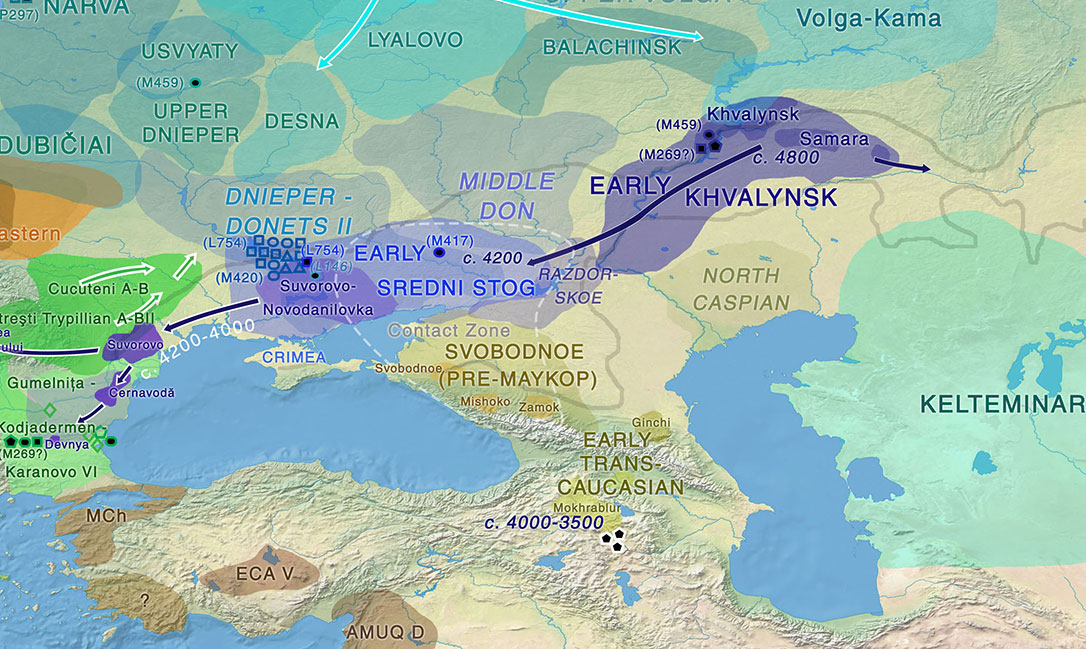
Both researchers, who collaborated with the latest genomic research, remade their models, and have to revise now their most recent proposals with the new data, influencing each new paper published with their pressure to be right in their previous models, and with new genomic data compelling them to change their theories under the pressure not to be too wrong again, in this strange vicious circle. Had they remained silent and committed to their archaeological theories, they could have been right all along, each one in their own way.
NOTE. BTW, in case you see ad hominem here too, I feel compelled to say that only thanks to their commitment to disentangle the truth about ancient migrations, and their readiness to collaborate with genetic research – unlike many others in their field – we know today what we know. If they have been wrong many times, it is because they have tried to connect the genetic dots as they were told. Only because of their readiness to explore their science further they should be praised by all. But, again, that does not mean that they cannot be wrong in their models…
Thanks to Anthony’s latest change of mind, we don’t have to hear the “cultural diffusion” argument anymore, and I consider this a great advance for the field.
NOTE. Not that there could not be prehistoric cultural diffusion events of language (i.e. not accompanied by genetic admixture), of course, but such theories, almost impossible to disprove, probably need much more than a simple “patron-client relationship” proposal and anthropometry to justify them, in a time when we will be able to see almost every meaningful personal exchange in Genomics…
Today – since the finding of Ukraine_Eneolithic sample I6561, of haplogroup R1a-Z93, dated ca. 4200 BC, and likely from the Sredni Stog culture – it seems more likely than ever that the expansion of R1a-Z645 subclades was in fact associated with the spread of steppe admixture probably near the North Pontic forest-steppe region, most likely from the Dnieper-Dniester or Upper Dniester region.
The appearance of a ‘late’ Z93 subclade already at such an early date, with steppe admixture, makes it still more likely that the Proto-Corded Ware culture, from where Corded Ware migrants of R1a-Z645 lineages later spread, was probably associated with this wide region.
In a parallel but unrelated migration, as it is now clear, steppe admixture also expanded with Yamna settlers of R1b-L23 lineages into the North Pontic steppe – from the North Caspian steppe, where it had developed previously as the Khvalynsk and (likely) Repin cultures -, roughly at the same time as Proto-Corded Ware expanded to the north, ca. 3300-3000 BC, and then expanded to the west into the Balkans (contributing to the formation of Balkan EBA cultures, and to the East Bell Beaker group).
NOTE. A migration of Yamna settlers northward along the Prut dated ca. 3000 BC or later could have justified the appearance of steppe admixture in the Dnieper-Dniester region, as I proposed for the Zvejnieki sample, although dates from Baltic samples are likely too early for that. For this to be corroborated, migrants should be accompanied up to a certain region by R1b-L23 lineages, and this could mean in turn a revival of Anthony’s original model of cultural diffusion of 2007. The most likely scenario, however, as predicted by Heyd, given the early appearance of steppe admixture and R1a-Z93 subclades in the forest-steppe during the 5th millennium, is that the admixture happened much earlier than that, fully unrelated to Late PIE migrations.
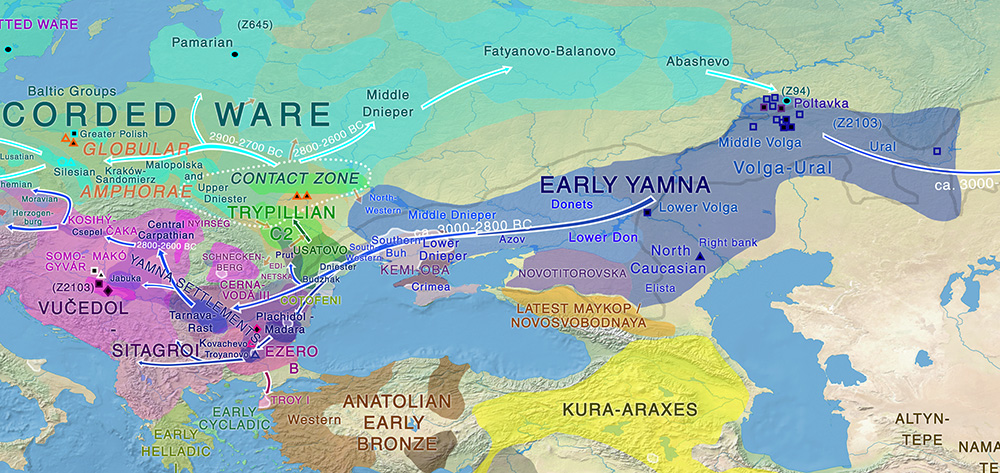
The modern Baltic and Slavic conundrum
As for some people of Northern European ancestry previously supporting a bulletproof Yamna (R1a/R1b) -> Corded Ware migration that was obviously wrong; now supporting different Sredni Stog -> Corded Ware groups representing Indo-Slavonic (and Germanic??) in a model that is clearly wrong: how are these attempts different from Western Europeans supporting the autochthonous continuity of R1b-P312 lineages against all recent data, from Indians supporting the autochthonous continuity of R1a-M417 lineages no matter what, and from the more recent trend of autochthonous continuity theories for N1c lineages and Uralic in Eastern Europe?
Modern Germanic-speaking peoples can trace their common language to Nordic Iron Age Proto-Germanic, Celts to La Tène’s expansion of Proto-Celtic, and Romance speakers to the Roman expansion (and to an earlier Proto-Italic), all three dating approximately to the Iron Age. Proto-Slavic is dated much later than that, and probably Proto-Baltic too (or maybe earlier depending on the dialectal proposal), with Balto-Slavic being possibly coeval with Pre-Proto-Germanic and Italo-Celtic, but probably slightly later than that. Also, the language ancestral to Slavic may be (like a theoretical Proto-Romance language) impossible to reconstruct with precision, due to multiple substrate (or superstrate?) influences on the wide territory where Proto-Slavic formed and expanded from, in close alliance with steppe communities of different ethnolinguistic backgrounds.
We know that proto-historic Germanic, Celtic, and Italic peoples spread from relatively small regions, and had almost nothing to do with historic groups speaking their daughter languages, let alone modern speakers. Baltic and Slavic are not different.
NOTE. We have read that Weltzin samples clustered closely to Central Europeans (especially Austrians), and at a certain distance from modern Poles. That’s the conclusion of Sell’s PhD thesis, and it may be right, if you take only modern samples for comparison. However, if you have read or thought that they represented some kind of “ancestral Germanic vs. Slavic” battle, please imagine Trump’s voice for my opinion: Wrroonng, wrroonng, wrroonng. They cluster closely with Bell Beaker migrants, Poland BA, and Únětice (in this order), which we now know thanks to the data from O&M 2018 and Mittnik et al. 2018. And we also know who they don’t cluster close too: Corded Ware and Trzciniec samples. Therefore, people from the region near the most likely homelands of Pre-Proto-Germanic and Proto-Balto-Slavic are – as expected – likely descendants from Bell Beaker migrants in Central Europe. The genetic relationship of those ancient samples to modern inhabitants of Central-East Europe? Not obvious – at all.
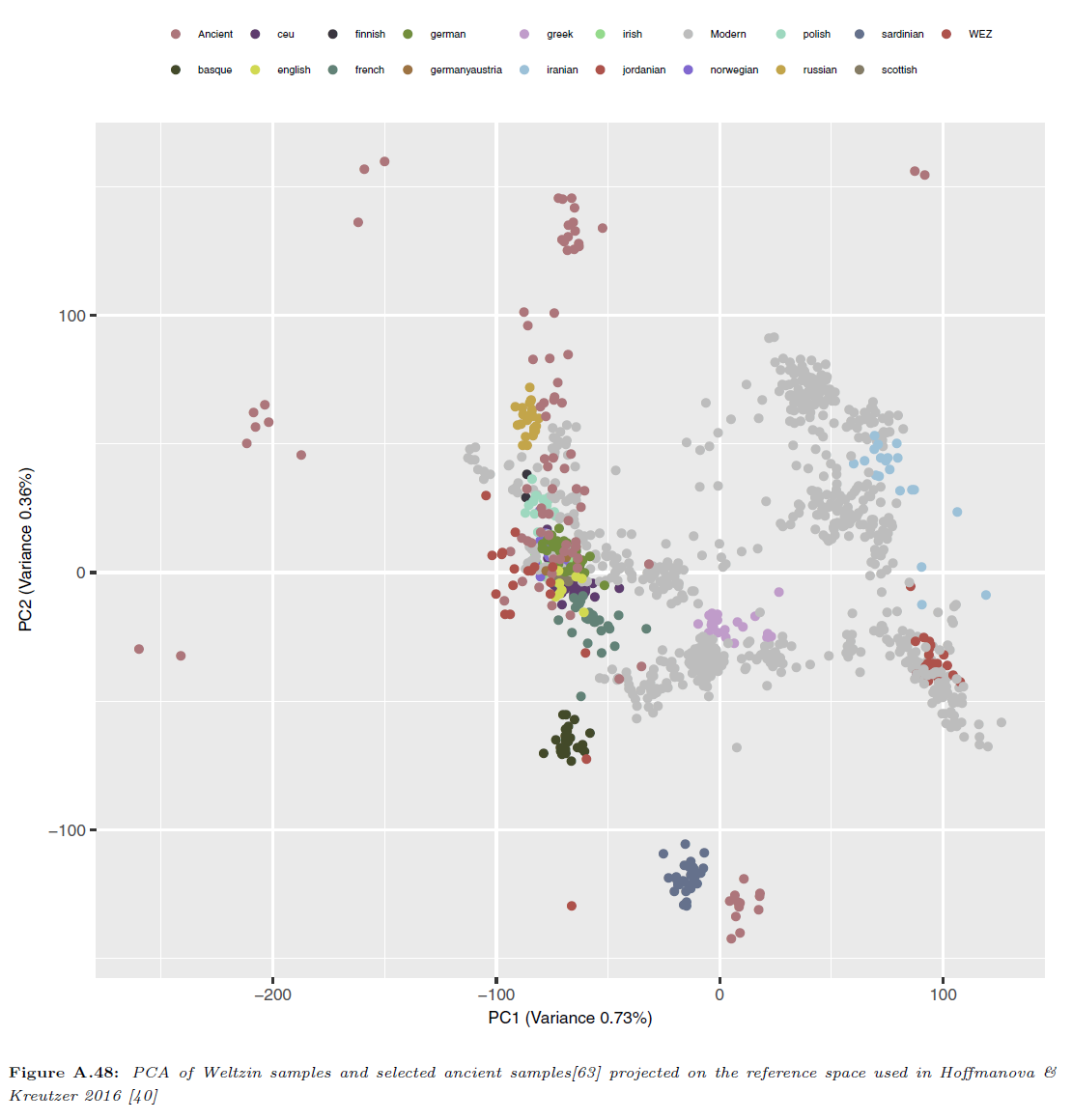
We also know (and have known for a long time, well before these recent papers) that the oldest attested Indo-European languages – Mycenaean, early Anatolian languages, and Indo-Aryan (through certain words in Mitanni inscriptions) – do not show continuity from the places where they were first attested to the Late and Middle Proto-Indo-European (steppe) homeland either. There should be no problem then in accepting that there is no linguistic, archaeological, or common sense reason to support that Balto-Slavic is older or shows more regional continuity than other IE languages from Europe.
NOTE. Oh yes, Balts saying “Baltic is the most similar language to PIE” I hear you thinking? Uh-huh, sure. And according to some Greeks (supported e.g. by the conclusions from Lazaridis et al. 2017) Mycenaeans were ‘autochthonous’, and Proto-Greek the most similar to PIE. For many Hindus, Vedic Sanskrit is in fact PIE), and the latest paper by Narasimhan et al. (2018) only reinforces this idea (don’t ask me why). Also, Caucasian scholar Gamkrelidze (with Ivanov) supported the origin of the language precisely in the Caucasus, with Armenian being thus the purest language. For Italians fans of Virgil and the Roman Empire, Latin (like Aeneas) comes from Anatolian linguistically and genetically, hence it must be the ‘oldest’ IE dialect alive… No, wait, Danish scholars Kroonen and Iversen quite recently asserted that Germanic is the oldest to branch off, then it should thus be nearest to PIE! I think you can see a pattern here…And don’t forget about the new Vasconic-Uralic hypotheses going on now, with Vasconic fans of R1b changing from Palaeolithic to Mesolithic, and now to European Neolithic and whatnot, or Uralic fans of N1c changing now from Mesolithic EHG to Siberia (for ancestry) or Central Asia (for N1c subclades), or whatever is necessary to believe in ‘continuity’ of their people following the newest genetic papers… Just pick whatever theory you want, call it “mainstream”, and that’s it.
So, if there is no reliable archaeological model connecting Bronze or Iron Age cultures to Eastern European cultures which are supposed to represent the Proto-Slavic and Proto-Baltic homelands…why on earth would any reasonable amateur (not to speak about scholars) dare propose any sort of genetic or linguistic continuity for thousands of years from PIE to early Slavs, a people whose first blurry appearance in historical records happened during the Middle Ages in rather turbulent and genetically admixed regions? It does not make any sense, and it had all odds against it. Blond hair, blue eyes, lactase persistence? Sure, and ABO group, brachycephaly, anthropometry… All very scientifish.
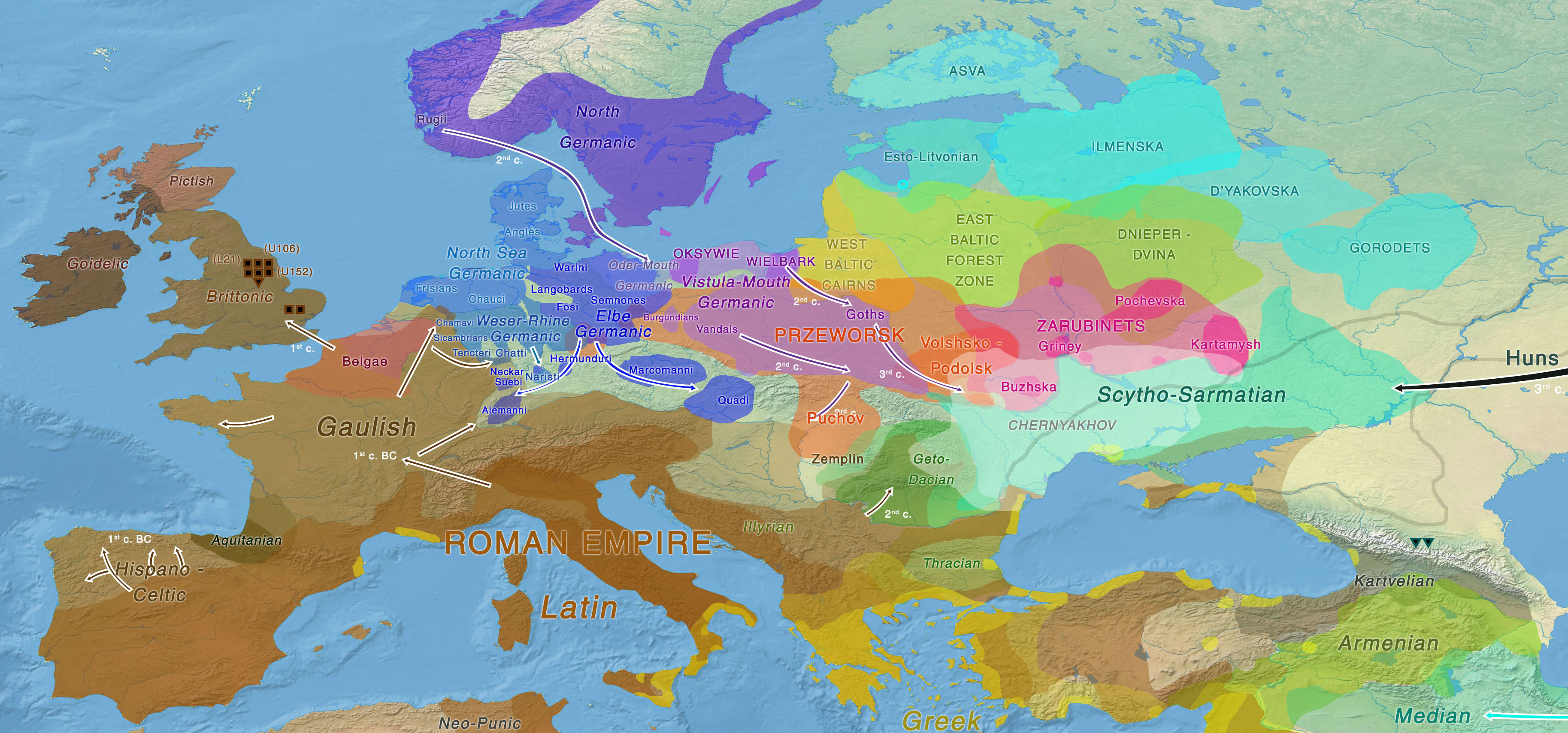
Where’s Proto-Slavic Wally?
Wrap-up
Human ancestry can only help refine solid academic theories, it cannot create one. Every new pet theory used to satisfy modern cultural pre- and misconceptions has failed, and it will fail again, and again, and again…
To have an own anthropological model of prehistoric migration requires time and study. It is not enough to play with software and to misuse traditional academic disciplines just to ‘prove’ some completely irrelevant, meaningless, and false continuity.
Related:
- Early Indo-Iranian formed mainly by R1b-Z2103 and R1a-Z93, Corded Ware out of Late PIE-speaking migrations
- Y-DNA haplogroup R1b-Z2103 in Proto-Indo-Iranians?
- Consequences of O&M 2018 (I): The latest West Yamna “outlier”
- Olalde et al. and Mathieson et al. (Nature 2018): R1b-L23 dominates Bell Beaker and Yamna, R1a-M417 resurges in East-Central Europe during the Bronze Age
- Reactionary views on new Yamna and Bell Beaker data, and the newest IECWT model
- The Indo-European demic diffusion model, and the “R1b – Indo-European” association
- The concept of “Outlier” in Human Ancestry (III): Late Neolithic samples from the Baltic region and origins of the Corded Ware culture
- New Ukraine Eneolithic sample from late Sredni Stog, near homeland of the Corded Ware culture